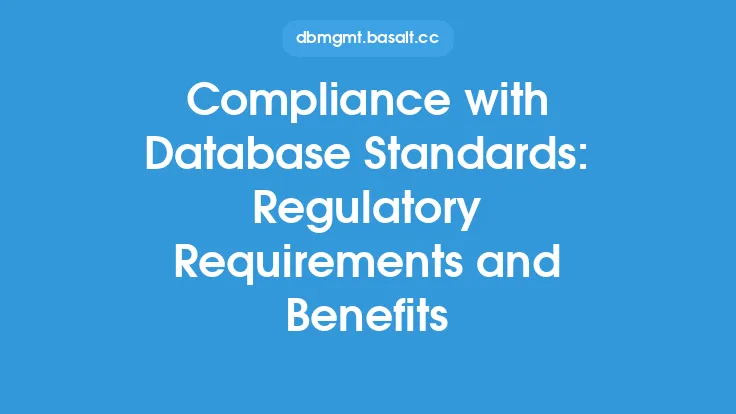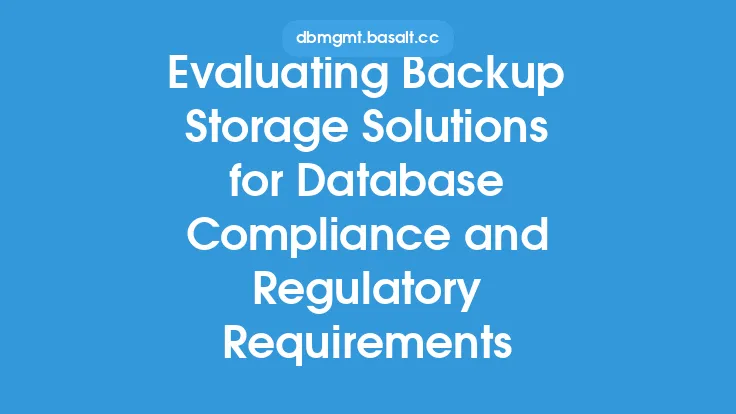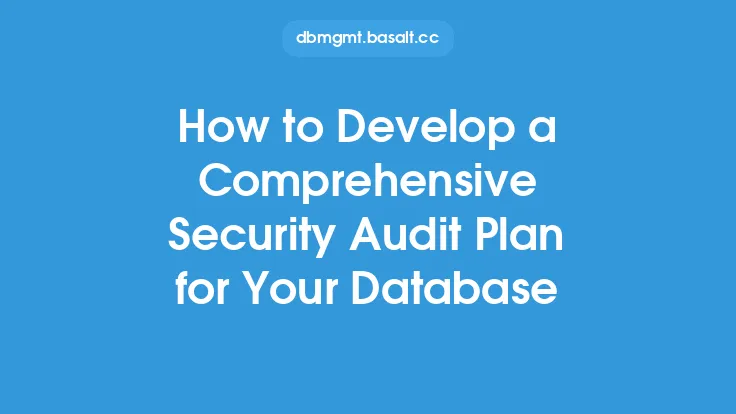As a database administrator, ensuring compliance with regulatory requirements is a critical aspect of your job. Database compliance refers to the process of ensuring that your database management system (DBMS) adheres to relevant laws, regulations, and industry standards. This involves implementing controls and procedures to protect sensitive data, prevent unauthorized access, and maintain data integrity. In this article, we will delve into the world of database compliance and regulatory requirements, exploring the key concepts, standards, and best practices that you need to know.
Introduction to Regulatory Requirements
Regulatory requirements for database compliance vary depending on the industry, location, and type of data being stored. Some of the most well-known regulations include the General Data Protection Regulation (GDPR) in the European Union, the Health Insurance Portability and Accountability Act (HIPAA) in the United States, and the Payment Card Industry Data Security Standard (PCI DSS) for credit card transactions. These regulations dictate how sensitive data should be collected, stored, processed, and protected. For example, GDPR requires organizations to implement data protection by design and default, while HIPAA mandates the use of secure protocols for transmitting electronic protected health information (ePHI).
Key Compliance Standards
Several compliance standards have been developed to help organizations ensure the security and integrity of their databases. These standards include:
- ISO 27001: A widely adopted international standard for information security management systems (ISMS)
- NIST Cybersecurity Framework: A framework for managing and reducing cybersecurity risk
- COBIT: A framework for IT governance and management
- PCI DSS: A standard for securing credit card transactions
These standards provide a set of guidelines and best practices for implementing controls, procedures, and policies to ensure database compliance. For instance, ISO 27001 requires organizations to conduct regular risk assessments, implement access controls, and establish incident response procedures.
Database Compliance Controls
To ensure database compliance, several controls must be implemented. These controls include:
- Access controls: Limiting access to authorized personnel and implementing role-based access control (RBAC)
- Authentication and authorization: Verifying user identities and ensuring that users have the necessary permissions to access data
- Data encryption: Protecting data both in transit and at rest using encryption algorithms such as AES and SSL/TLS
- Auditing and logging: Monitoring and recording database activity to detect and respond to security incidents
- Backup and recovery: Ensuring that data can be recovered in the event of a disaster or data loss
These controls help to prevent unauthorized access, protect sensitive data, and maintain data integrity.
Compliance and Database Design
Database design plays a critical role in ensuring compliance. A well-designed database should take into account the principles of data protection by design and default. This includes:
- Data minimization: Collecting and storing only the minimum amount of data necessary
- Data anonymization: Removing personally identifiable information (PII) from data sets
- Data segregation: Separating sensitive data from non-sensitive data
- Data retention: Establishing policies for data retention and disposal
A compliant database design should also consider the use of data masking, tokenization, and encryption to protect sensitive data.
Compliance and Database Operations
Database operations, such as data backups, upgrades, and patches, must also be compliant with regulatory requirements. This includes:
- Change management: Implementing a change management process to ensure that changes to the database are properly authorized, tested, and documented
- Patch management: Regularly applying security patches and updates to the DBMS and underlying operating system
- Backup and recovery: Ensuring that backups are properly encrypted, stored, and retrievable
- Monitoring and incident response: Continuously monitoring the database for security incidents and having an incident response plan in place
Compliant database operations help to prevent data breaches, ensure business continuity, and maintain data integrity.
Compliance Auditing and Reporting
Compliance auditing and reporting are essential components of database compliance. This includes:
- Conducting regular audits: Performing internal and external audits to ensure compliance with regulatory requirements
- Generating compliance reports: Creating reports to demonstrate compliance with regulatory requirements
- Identifying and addressing compliance gaps: Identifying areas for improvement and implementing corrective actions
Compliance auditing and reporting help to ensure that the database is compliant with regulatory requirements and provide a framework for continuous improvement.
Best Practices for Database Compliance
To ensure database compliance, several best practices should be followed. These include:
- Implementing a compliance program: Establishing a compliance program to oversee database compliance
- Providing training and awareness: Educating database administrators and users on compliance requirements and best practices
- Continuously monitoring and reviewing: Regularly monitoring and reviewing database activity to detect and respond to security incidents
- Implementing automation and scripting: Automating compliance tasks and using scripting to streamline compliance processes
These best practices help to ensure that the database is compliant with regulatory requirements and provide a framework for continuous improvement.
Conclusion
In conclusion, database compliance and regulatory requirements are critical aspects of database administration. By understanding the key concepts, standards, and best practices outlined in this article, database administrators can ensure that their databases are compliant with regulatory requirements and provide a secure and reliable platform for storing and processing sensitive data. Remember, compliance is an ongoing process that requires continuous monitoring, review, and improvement. By following best practices and staying up-to-date with regulatory requirements, you can help to protect your organization's sensitive data and maintain the trust of your customers and stakeholders.





